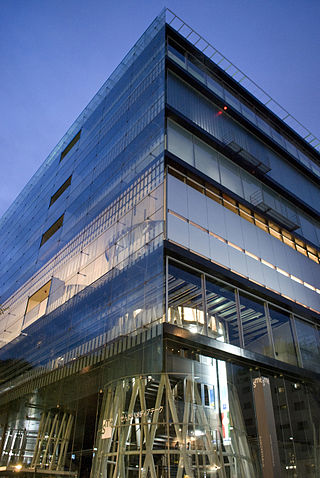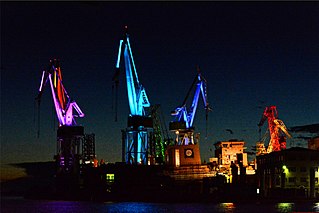
Kisho Kurokawa was a leading Japanese architect and one of the founders of the Metabolist Movement.

Toyo Ito is a Japanese architect known for creating conceptual architecture, in which he seeks to simultaneously express the physical and virtual worlds. He is a leading exponent of architecture that addresses the contemporary notion of a "simulated" city, and has been called "one of the world's most innovative and influential architects."

Kunio Maekawa was a Japanese architect and a key figure in Japanese postwar modernism. His distinctive architectural language deftly blended together elements of traditional Japanese design and modernist tenets from Europe, drawing from early career work experiences in the offices of Le Corbusier and Antonin Raymond. He is especially known for the Tokyo Bunka Kaikan and the National Museum of Modern Art, Tokyo. His home, which he designed and completed in 1942, has been preserved and permanently installed in the Edo-Tokyo Open Air Architectural Museum.
George S. Sexton, III is an American designer, specializing in the areas of lighting design, museum design and museum planning services.
The Illuminating Engineering Society (IES), formerly the Illuminating Engineering Society of North America (IESNA), is an industry-backed, not-for-profit, learned society that was founded in New York City on January 10, 1906. The IES's stated mission is "to improve the lighted environment by bringing together those with lighting knowledge and by translating that knowledge into actions that benefit the public".

Rogier van der Heide is a designer born in the Netherlands who lives in Liechtenstein. He is noted especially as a C-suite design executive and as a lighting designer of public and commercial projects all over the world.
Ikko Tanaka was a Japanese graphic designer. Tanaka is widely recognized for his prolific body of interdisciplinary work, which includes graphic identity and visual matter for brands and corporations including Seibu Department Stores, Mazda, Issey Miyake, Hanae Mori, and Expo 85. He is credited with developing the foundational graphic identity for lifestyle brand Muji, emphasizing the "no brand" quality of their products through unadorned, charming line drawings paired with straightforward slogans. His use of bold, polychromatic geometries and his harnessing of the dynamic visual potential of typography are undergirded by a sensitivity towards traditional Japanese aesthetics. Though keenly sensitive to historical precedents and established conventions, Tanaka nevertheless maintained a degree of playfulness in his work, manipulating color, scale, and form to reconfigure familiar iconographies into fresh and accessible visual representations.
Speirs Major is a UK lighting design practice founded by Jonathan Speirs (1958-2012) and Mark Major in 1993. The practice is noted for its illumination of many prominent buildings, including Barajas International Airport, 30 St Mary Axe, the Millennium Dome and the interior of St. Pauls Cathedral. The firm has also developed lighting master plans for several British cities, including Cambridge, Coventry, Durham, Newcastle, and for major private developments including Greenwich Peninsula and King’s Cross Central, London.
Focus Lighting is a New York City based architectural lighting design firm founded by Paul Gregory in 1987.

Sendai Mediatheque is a library in Sendai, Miyagi Prefecture, Japan. It was designed by Toyo Ito in 1995 and completed in 2001.
Syoh Yoshida is a Japanese artist of the nihonga and ink painting genre.

L'Observatoire International is a lighting design firm established by Hervé Descottes in 1993 in New York City. The firm works within a range of different spatial expressions including architecture, landscape, urban, and fine art projects.
Yasuki Hiramatsu (平松 保城, Hiramatsu Yasuki, was born in Osaka, Japan. He was a Japanese artist and considered a pioneer of modern jewelry in Japan. He served as a member of the Japan Craft Design Association, the Japan Jewellery Designers Association, and the Mitglied von der Gesellschaft für Goldschmiedekunst.
Takashi Yamaguchi is a Japanese architect, born in Kyoto. He graduated from Kyoto University and worked for Tadao Ando and Associates. He founded his own architectural firm, Takashi Yamaguchi & Associates, in 1996. Yamaguchi served as a visiting professor at the Osaka University of Arts in 2005, and in 2009 served as visiting professor at Columbia University and visiting scholar at Harvard. He is a professor at Osaka Sangyo University and a member of the Japan Institute of Architects and the Architectural Institute of Japan. He is an elite member of the Supporters of Romania Research at the Academy of Romanian Scientists. He is also a Regional President of Asia Designer Communication Platform.

Dean Skira is a Croatian lighting designer. Skira founded his own lighting design practice in 1990 in New York City, USA. He lives and works in Pula, Croatia.
Tenmyouya Hisashi is a Japanese contemporary artist.

Shiro Takatani is a Japanese artist. He currently lives and works in Kyoto. Co-founder and visual creator of the group Dumb Type since 1984, he also became artistic director of the group from 1995 and also started an active solo career in 1998.
Naoko Tosa is a Japanese media artist based in Fukuoka, Japan. In recent years Tosa has been creating artwork expressing Japanese tradition and culture without utilizing digital technology but rather by taking photographic captures of water and flowers in motion at 2000 frames per second. Much of her focus is based on Japanese Zen, Shinto and Rinpa traditions. Rinpa, a school of painting which traces its origins to 17th century Kyoto emphasizes natural subjects, refinement and the use of gold leaf, and is a key influence in Tosa's most recent works.
Office for Visual Interaction (OVI) is an architectural lighting design firm founded in 1997 by Jean Sundin and Enrique Peiniger. Based in New York City, OVI specializes in lighting & daylighting design for international projects of varying scales and types, including urban master plans, cultural and civic buildings, hospitality works, and product design. OVI's design philosophy is such that light is treated as a primary architectural component, transforming spaces through its interactions with surfaces, volumes and materials. OVI is known for their visual storytelling, “approach[ing] their projects with an investigative line of inquiry, asking questions whose answers reveal the project’s underlying narrative.”
Hikaru Fujii is a contemporary Japanese artist who explores the relationship between art, history, and social activism. Primarily working in documentary film and multi-channel video installation, Fujii employs archival research, fieldwork, interviews, and workshops to create artworks to examine the relationships between historical narrative and education, structural violence, crisis, race, and power. Of particular interest for him are the role and responsibility of museums and institutions as sites that preserve and perpetuate specific historical narratives. After the 2011 Great East Japan Earthquake and nuclear disaster, Fujii has actively documented the disaster and raised awareness around the world about the situation in Japan.







